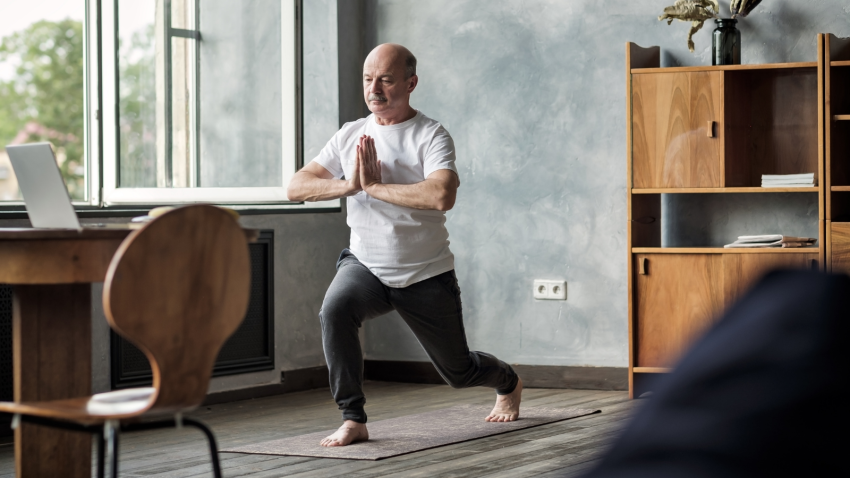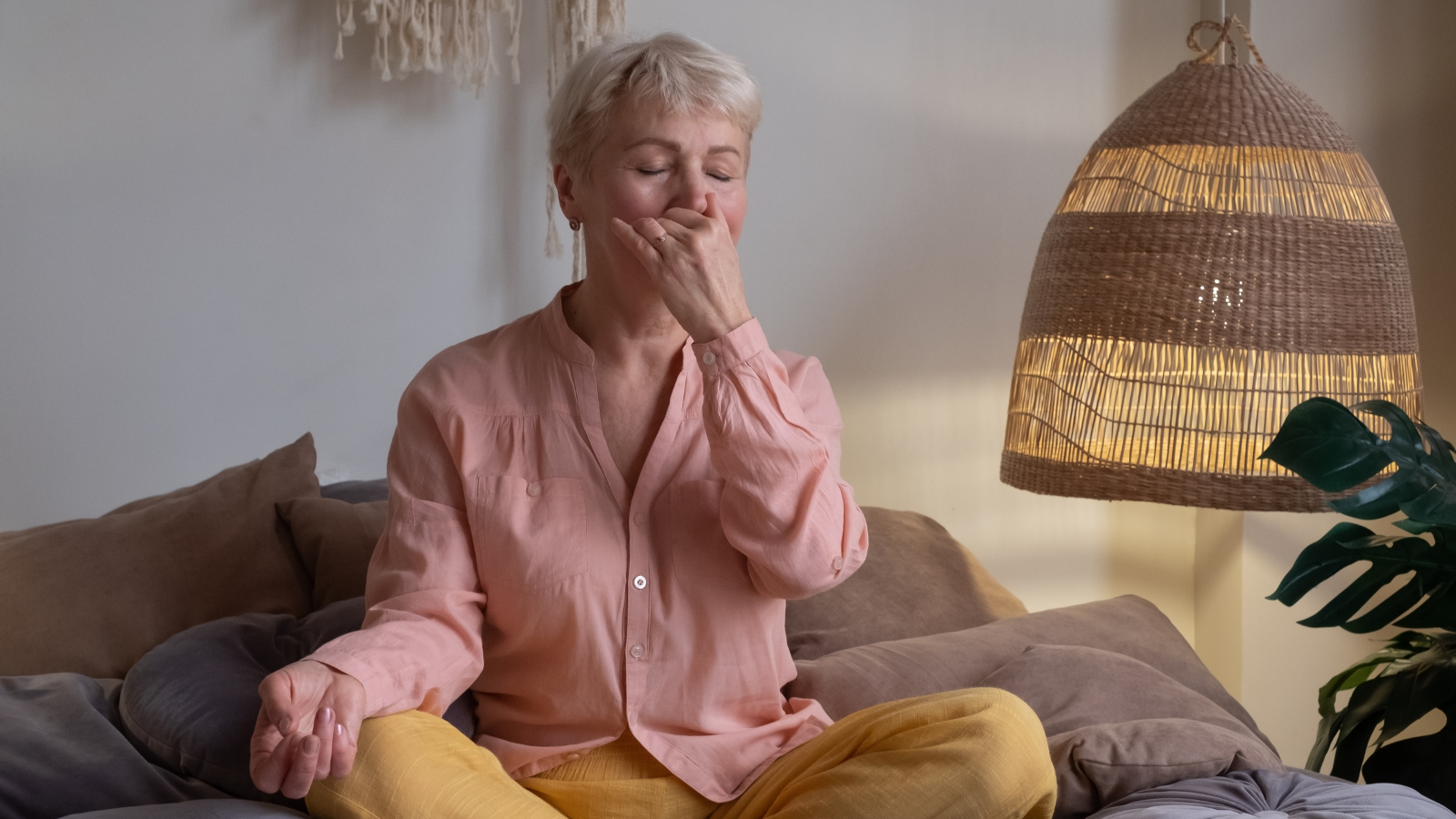View basket (0 items $0.00)

Yoga for Heart Health: Research Shows Yoga May Help Atrial Fibrillation
A few years ago, I wrote a blog post about yoga and atrial fibrillation, inspired by both a personal experience with a student who had an acute bout of rapid heart rate due to “A fib” during a yoga workshop in 2001 and a study (in 2013) that was underway to see if yoga could be of help with this condition.
Since that time, several friends of mine, men, and women, ranging in age from 54 to 75, have developed atrial fibrillation and have undergone a variety of Western treatments, with variable success, to try and bring the upper chambers of the heart (the atria) back into normal rhythm. And, that 2013 study on yoga and atrial fibrillation was completed and showed great promise for yoga as an adjunctive treatment for those with this condition. We will get to that in a few moments. So, it felt like a good time to check in again!
What is Atrial Fibrillation?
For those unfamiliar with atrial fibrillation, it is a condition of the heart that interferes with the normal electrical conduction of the impulses that typically result in the rhythmic contraction of heart moment by moment. It is the most common treatable type of arrhythmia or irregular heart rhythm. Although it can be present without symptoms, it more often causes fatigue, especially with activity, chest pain, shortness of breath, dizziness, and palpitations (a feeling of rapid rate, pounding, or fluttering in chest).
Atrial fibrillation causes the heart to beat much faster than normal and the upper and lower chambers of the heart get out of sync. This can result in poor emptying of the larger lower chambers of the heart, increasing the chances of blood clots forming there and getting shot out into the brain. When this happens, people suffer from strokes, which can cause significant disability or death. It can also gradually lead the heart to swell and work poorly, a condition called congestive heart failure.
Risk Factors for Atrial Fibrillation
 It is worth knowing a bit about the risk factors for developing atrial fibrillation, as yoga has been shown in studies to address many of these underlying issues. So, what are they?
It is worth knowing a bit about the risk factors for developing atrial fibrillation, as yoga has been shown in studies to address many of these underlying issues. So, what are they?
According to the CDC, they include:
-
High blood pressure* (the most significant factor)
-
Advancing age
-
Obesity*
-
European ancestry
-
Diabetes*
-
Heart failure
-
Ischemic heart disease*
-
Overactive thyroid gland
-
Chronic kidney disease
-
Moderate to heavy alcohol intake*
-
Smoking*
-
Enlargement of the left side of the heart.
*Yoga can address or may help prevent these conditions.
Treatment by your heart specialist can include medications to try and control the rhythm of your heart, blood-thinning medications to try and prevent you from developing clots in the big chambers of the heart, and surgical interventions to try and bring the heart rhythm back toward normal. Oh, and lowering risk factors via lifestyle changes, something yoga is ideally suited to address!
Results of the Study on Yoga and Atrial Fibrillation
 It’s time to turn back to the study that was underway back in 2013 when I wrote my last blog post on this topic. Once completed, the study revealed some very positive benefits for the yoga group. This was a single-center study that followed 49 people with atrial fibrillation who were experiencing symptoms of the condition. For the first three months of the study, this group was used as the “control” group by simply monitoring their symptoms, heart monitors, blood pressure, and assessing their quality-of-life measures. Then, for the next three months, they became the “study” group and did a 60-minute yoga class twice a week. They were encouraged to practice at home as well.
It’s time to turn back to the study that was underway back in 2013 when I wrote my last blog post on this topic. Once completed, the study revealed some very positive benefits for the yoga group. This was a single-center study that followed 49 people with atrial fibrillation who were experiencing symptoms of the condition. For the first three months of the study, this group was used as the “control” group by simply monitoring their symptoms, heart monitors, blood pressure, and assessing their quality-of-life measures. Then, for the next three months, they became the “study” group and did a 60-minute yoga class twice a week. They were encouraged to practice at home as well.
When the researchers compared the two-time frames, there were significant improvements once yoga was introduced: significant decreases in episodes of atrial fibrillation (30 to 40 percent lower), whether with or without symptoms. Other benefits included decreases in other irregular heart rhythms, along with both depression and anxiety. Quality-of-life measures also improved, such as vitality, physical and social functioning, and general health.
After yoga was instituted, these people also had lower blood pressure and heart rate reading, which was also considered significant. The authors of a follow-up paper on this study suggested that these powerful effects, and the lack of side effects from practicing yoga, especially when compared to medication and surgical procedure side effects, made yoga a “favorable adjunct” to those typical Western medical treatments presently used.
The Case for Practicing Yoga
 We don’t know the exact mechanism that yoga is able to have this dampening effect on atrial fibrillation. It is known that the autonomic nervous system plays at least a partial role in how atrial fibrillation develops. So, one theory on how yoga helps is that yoga brings the sympathetic and parasympathetic parts of that system back into balance through its influence on the hypothalamic-pituitary-adrenal axis (HPA axis), which is part of the communication between the brain and our hormone systems.
We don’t know the exact mechanism that yoga is able to have this dampening effect on atrial fibrillation. It is known that the autonomic nervous system plays at least a partial role in how atrial fibrillation develops. So, one theory on how yoga helps is that yoga brings the sympathetic and parasympathetic parts of that system back into balance through its influence on the hypothalamic-pituitary-adrenal axis (HPA axis), which is part of the communication between the brain and our hormone systems.
So, where does that leave us in 2022? From my perspective as both a Western-trained physician and a yoga therapist, I am encouraged by the overall beneficial impacts that a regular yoga practice can have on 1) lowering our chances of developing atrial fibrillation in the first place, as mentioned above, and 2) on the potential use of yoga when someone does develop atrial fibrillation. Yoga has the potential to allow my friends affected by this condition to reduce both symptoms and episodes of atrial fibrillation, and potentially live longer, healthier lives.
And since there is no downside to starting appropriate* yoga practices, all more reason for all of us to start or keep practicing yoga regularly!
*Special note: It is probably wise for anyone with atrial fibrillation who wants to start doing yoga as a means of addressing their condition to consult with a yoga therapist to develop an appropriate yoga practice.
 BAXTER BELL, MD, eRYT 500, C-IAYT
BAXTER BELL, MD, eRYT 500, C-IAYT
Baxter Bell, MD, has been actively deepening his understanding of the power of yoga since making the stress-reducing move from a career as a busy family doctor to that of a yoga teacher and medical acupuncturist. Baxter is a graduate of the Piedmont Yoga Studio’s 18-month Advanced Studies Program, and served as Director of PYS’s Deep Yoga Program for many years, teaching the Experiential Anatomy, Yoga Technique, and Yoga Methodology portions of that training. He is on faculty for several Yoga Teacher Training and Yoga Therapy Training programs around the country. Baxter is a Certified Yoga Therapist, a level of training denoted by C-IAYT. He is also co-author with Nina Zolotow of the book Yoga for Healthy Aging. Baxter’s teaching has been influenced by the many gifted teachers he has studied with over the years, including Rodney Yee, Patricia Walden, Erich Schiffmann, Richard Rosen, Mary Paffard, TKV Desikachar, and Donald Moyer. Baxter is a featured presenter and has therapeutic yoga classes on the website Yoga U Online as well as in Yoga Journal’s DVD, Yoga for Stress, and has written articles for yoga publications such as Yoga Journal and the International Journal of Yoga Therapy. He is co-founder and a past contributing writer for the blog Yoga for Healthy Aging (lots of great archived articles by Baxter!) and his new blog is called What’s On Your (Yoga) Mind? Baxter is involved in the integration of therapeutic applications of yoga with Western medicine and presently serves on the board of the International Association of Yoga Therapists. Baxter teaches public and specialty Back Care yoga classes in Oakland and Berkeley in the San Francisco Bay Area, California, as well as workshops and retreats around the United States and internationally.
Sources:
CDC info on A fib: https://www.cdc.gov/heartdisease/atrial_fibrillation.htm
Mayo Clinic info on A fib: https://www.mayoclinic.org/diseases-conditions/atrial-fibrillation/symptoms-causes/syc-20350624
Studies of Yoga and A-fib:
The original 2013 study:
https://pubmed.ncbi.nlm.nih.gov/23375926/
Short interview with the researcher
https://www.youtube.com/watch?v=f4hwjveGQ6w
A 2015 review of 2013 The Yoga My Heart study:
https://www.ncbi.nlm.nih.gov/pmc/articles/PMC4672029/
Featured Courses









